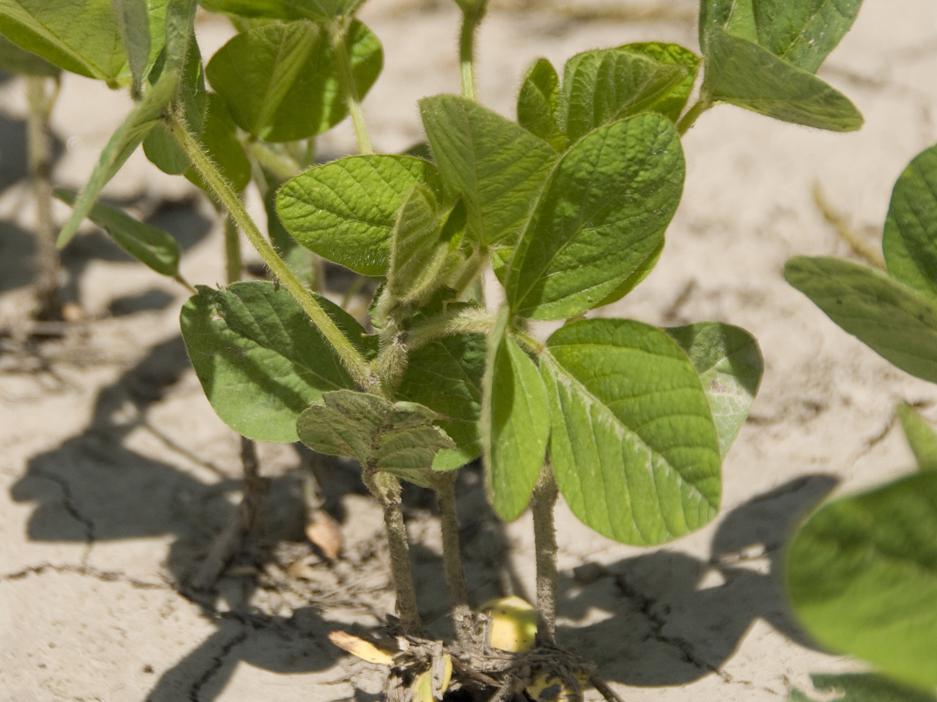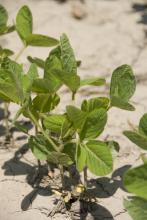Information Possibly Outdated
The information presented on this page was originally released on April 27, 2012. It may not be outdated, but please search our site for more current information. If you plan to quote or reference this information in a publication, please check with the Extension specialist or author before proceeding.
Warm March allowed early soybean planting
MISSISSIPPI STATE -- Soybeans are usually an early-planted crop, but an unseasonably warm March gave some growers a chance to get in the fields a little ahead of the typical April 1 start date.
Trent Irby, Mississippi State University Extension Service state soybean specialist, said the crop was on track at the end of April.
“Many parts of the state got planted about two weeks earlier than normal,” Irby said. “Several places remained too wet to plant until mid-April, but overall, we’re slightly ahead of schedule.”
The U.S. Department of Agriculture estimated Mississippi growers will plant 1.75 million acres of soybeans, down just 4 percent from 2011. As of April 22, about 40 percent of the state’s soybean crop had been planted and 26 percent had emerged. These numbers are slightly above the five-year average of 34 percent planted and 16 percent emerged by this same time.
“Winter wheat will soon be ready to harvest. If soil moisture conditions are favorable, many growers may choose to have a late-planted crop of soybeans double-cropped with their wheat rather than letting the ground lay fallow,” Irby said. “This could mean that some of the state’s soybeans will not be planted until June.”
Late April saw several nights of temperatures in the 40s and 50s, but there was no frost in the state. A bigger concern is recent windy days that have pulled needed moisture out of the soil.
“In certain areas that have not received sufficient rainfall, growers are waiting for a rain before they resume planting,” Irby said. “It is likely that many other areas of the state will need rain in the next week or so to maintain adequate soil moisture for planting.”
Anthony Bland, Extension Tunica County director, said his county got about an inch of scattered rain in late April, but areas are still dry.
“We have a few areas in the northern portion of the county that are so dry that we’ll probably need another shower before we resume planting,” Bland said.
Despite dry soils, Bland estimated more than 80 percent of the county’s soybeans had been planted by the last week of April. Tunica County’s biggest crop is soybeans, and Bland said about 60 percent of the county’s estimated 120,000 acres of soybeans are irrigated.
“We’re in pretty good shape with planting and need just a little more rain to finish off the planting season,” Bland said. “This is one of the earliest crops on record for soybeans and rice.”
Planting soybeans early is a sound strategy for best harvest results.
“It’s been proven over the years that the earlier you can get your crop planted, the higher your soybean yields will be,” Bland said. “Early-planted soybeans have a better chance of taking advantage of summer rains and setting their crop before the weather gets very hot and dry in August.”
Good prices drove predictions of high soybean acreage. John Michael Riley, Extension agricultural economist, said current 2012 crop contract prices in the Delta are about $13.90 per bushel. September soybean futures prices are $14.11 per bushel, six cents above September futures prices last year.
“Soybean prices have been moving higher since December 2011,” Riley said. “Tight global supplies, largely due to dry conditions in South America, have been a boon for the upcoming crop prices as well as last year's crop prices. A smaller-than-expected U.S. acreage number also helped push prices up.”







